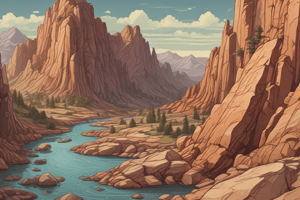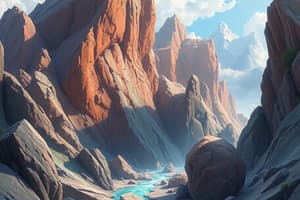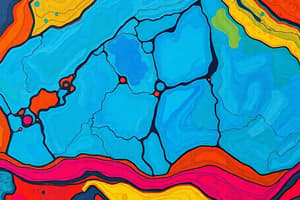Podcast
Questions and Answers
Which process primarily contributes to the formation of sedimentary rocks in Ireland?
Which process primarily contributes to the formation of sedimentary rocks in Ireland?
- Transformation by extreme heat and pressure
- Cooling and solidification of magma
- Volcanic eruptions forming hexagonal columns
- Accumulation and cementation of sediments (correct)
If a geologist discovers a rock sample containing large crystals and visible layers in County Donegal, which type of rock is it most likely?
If a geologist discovers a rock sample containing large crystals and visible layers in County Donegal, which type of rock is it most likely?
- Schist or Gneiss (correct)
- Sandstone
- Limestone
- Basalt
The Giant's Causeway is composed of:
The Giant's Causeway is composed of:
- Basalt (correct)
- Limestone
- Quartzite
- Granite
Which geological event was responsible for the formation of granite in the Dublin and Wicklow Mountains?
Which geological event was responsible for the formation of granite in the Dublin and Wicklow Mountains?
What characteristic geological feature defines the landscape of the Burren in County Clare?
What characteristic geological feature defines the landscape of the Burren in County Clare?
If analyzing a rock sample from the Cork and Kerry mountains, which rock type would you most likely identify?
If analyzing a rock sample from the Cork and Kerry mountains, which rock type would you most likely identify?
The rocks along the Copper Coast in County Waterford primarily date back to which geological period?
The rocks along the Copper Coast in County Waterford primarily date back to which geological period?
Which process leads to the formation of quartzite in the Twelve Bens and Maumturks of Connemara?
Which process leads to the formation of quartzite in the Twelve Bens and Maumturks of Connemara?
Which of the following characteristics is most indicative of an intrusive igneous rock?
Which of the following characteristics is most indicative of an intrusive igneous rock?
What primary process leads to the formation of clastic sedimentary rocks?
What primary process leads to the formation of clastic sedimentary rocks?
Which condition is essential for the formation of metamorphic rocks?
Which condition is essential for the formation of metamorphic rocks?
In the rock cycle, what process directly follows weathering and erosion?
In the rock cycle, what process directly follows weathering and erosion?
Which rock type is most likely to contain fossils?
Which rock type is most likely to contain fossils?
Which of the following pairs of rocks represents an extrusive igneous rock and a foliated metamorphic rock, respectively?
Which of the following pairs of rocks represents an extrusive igneous rock and a foliated metamorphic rock, respectively?
Limestone is formed by the precipitation of dissolved minerals from water. This formation process classifies limestone as which type of rock?
Limestone is formed by the precipitation of dissolved minerals from water. This formation process classifies limestone as which type of rock?
Which of the following statements accurately describes how rocks contribute to understanding Earth's history?
Which of the following statements accurately describes how rocks contribute to understanding Earth's history?
Flashcards
What are rocks?
What are rocks?
Naturally occurring solid aggregates of minerals or mineraloids.
Igneous Rocks
Igneous Rocks
Form from the solidification of magma or lava.
Intrusive Igneous Rocks
Intrusive Igneous Rocks
Crystallize below Earth's surface, resulting in large crystals due to slow cooling.
Extrusive Igneous Rocks
Extrusive Igneous Rocks
Signup and view all the flashcards
Sedimentary Rocks
Sedimentary Rocks
Signup and view all the flashcards
Clastic Sedimentary Rocks
Clastic Sedimentary Rocks
Signup and view all the flashcards
Metamorphic Rocks
Metamorphic Rocks
Signup and view all the flashcards
The Rock Cycle
The Rock Cycle
Signup and view all the flashcards
Granite in Ireland
Granite in Ireland
Signup and view all the flashcards
Basalt (Giant's Causeway)
Basalt (Giant's Causeway)
Signup and view all the flashcards
Limestone in Ireland
Limestone in Ireland
Signup and view all the flashcards
Sandstone in Ireland
Sandstone in Ireland
Signup and view all the flashcards
Quartzite in Connemara
Quartzite in Connemara
Signup and view all the flashcards
Study Notes
- Rocks are naturally occurring solid aggregates of minerals or mineraloids, forming Earth's outer solid layer (crust).
- Rocks have been integral to human civilization for thousands of years, used in construction, art, and various industries.
Types of Rocks
- Rocks are classified into igneous, sedimentary, and metamorphic types based on their formation process.
Igneous Rocks
- Igneous rocks form from the solidification of molten magma or lava.
- Intrusive igneous rocks crystallize below Earth's surface, resulting in large crystals from slow cooling; granite is an example.
- Extrusive igneous rocks form when lava cools quickly on Earth's surface, resulting in fine-grained textures; basalt is common.
Sedimentary Rocks
- Sedimentary rocks form from the accumulation and compaction of mineral and organic particles, often having distinct layers and fossils.
- Clastic sedimentary rocks are made from fragments of other rocks cemented together like sandstone.
- Chemical sedimentary rocks form when dissolved minerals precipitate from water, like limestone.
- Organic sedimentary rocks are composed of organic material such as coal.
Metamorphic Rocks
- Metamorphic rocks arise from the transformation of existing rock types through heat, pressure, or chemically active fluids, altering mineral composition and structure without entirely melting.
- Foliated metamorphic rocks are characterized by a layered or banded appearance, such as schist
- Non-foliated metamorphic rocks lack distinct layers, like marble.
The Rock Cycle
- The rock cycle illustrates the process that transforms one rock type into another over geological time.
- Weathering and erosion break down rocks into smaller particles.
- Sedimentation involves the deposition and compaction of sediments into sedimentary rocks.
- Metamorphism transforms rocks into metamorphic types through heat and pressure.
- Melting converts rocks into magma, leading to the formation of igneous rocks.
Importance of Rocks
- Rocks serve as historical records, revealing information about past environments and life forms.
- Rocks provide essential resources, such as minerals and fossil fuels.
- Rocks influence the landscape, affecting soil formation and topography.
Igneous Rocks in Ireland
- Igneous rocks in Ireland are primarily found in areas that were once volcanic.
- Granite is predominantly found in the Dublin and Wicklow Mountains and the Mourne Mountains, formed around 400 million years ago during the Caledonian orogeny.
- Basalt is most famously seen at the Giant's Causeway in County Antrim, known for its unique hexagonal columns, resulting from volcanic activity around 60 million years ago.
Sedimentary Rocks in Ireland
- Sedimentary rocks form from sediment accumulation and are widely distributed.
- Limestone is the most common rock type in Ireland, found in the midlands like the Burren in County Clare, known for its karst landscape and biodiversity.
- Sandstone is primarily found in the Munster region, including the Cork and Kerry mountains; typically older and red or brown.
Metamorphic Rocks in Ireland
- Schist and Gneiss are found in the northwest, particularly in Counties Donegal and Mayo, dating back to the Precambrian era.
- Quartzite is prominent in the Twelve Bens and Maumturks of Connemara, displaying a hard, glassy surface.
Unique Geological Features in Ireland
- The Burren in County Clare is a unique area with limestone pavements, fossils, and distinctive flora.
- The Copper Coast in County Waterford is a UNESCO Global Geopark, featuring cliffs, coves, and sea stacks from the Devonian Period.
- The Mourne Mountains in County Down consist largely of granite and are famous for natural beauty forming during the same period as the Wicklow Mountains.
Studying That Suits You
Use AI to generate personalized quizzes and flashcards to suit your learning preferences.





